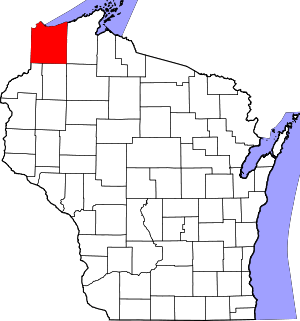Brule, Wisconsin
Brule is a town in Douglas County, Wisconsin, United States. The population was 591 at the 2000 census. The town takes its name from the nearby Bois Brule River, which flows north into Lake Superior.[3] The census-designated place of Brule and unincorporated communities of Bellwood, Waino, and Winneboujou are located in the town of Brule.
Brule, Wisconsin | |
|---|---|
| Motto(s): "Home to the River of Presidents" | |
 Location of Brule, Wisconsin | |
| Coordinates: 46°33′58″N 91°35′39″W | |
| Country | |
| State | |
| County | Douglas |
| Area | |
| • Total | 55.9 sq mi (144.7 km2) |
| • Land | 55.7 sq mi (144.3 km2) |
| • Water | 0.2 sq mi (0.5 km2) |
| Elevation | 1,093 ft (333 m) |
| Population (2000) | |
| • Total | 591 |
| • Density | 10.6/sq mi (4.1/km2) |
| Time zone | UTC-6 (Central (CST)) |
| • Summer (DST) | UTC-5 (CDT) |
| ZIP code | 54820 |
| Area code(s) | 715 and 534 |
| FIPS code | 55-10575[2] |
| GNIS feature ID | 1582879[1] |
| Website | Town of Brule Wisconsin |
History
The Town of Brule was founded on November 13, 1886.[4]
The Brule River is one of the preeminent trout streams in North America, with abundant native and migratory steelhead, brown, and brook trout. Located near the primary trout spawning bed for western Lake Superior, Brule is a destination for serious fly fishermen from the around the world.
Four United States presidents, Calvin Coolidge, Herbert Hoover, Harry Truman, and Dwight Eisenhower, have summered near Brule in some of the many Adirondack-style lodges erected by prominent families from Minneapolis and Milwaukee.[5]
In 1899, Professor Ulysses Sherman Grant, of Northwestern University, inspected the Brule, Wisconsin area for ancient copper deposits.[6] CIA chief of counterintelligence James Jesus Angleton had a home on the river.
Geography
According to the United States Census Bureau, the town has a total area of 55.9 square miles (144.7 km2), of which, 55.7 square miles (144.3 km2) of it is land and 0.2 square miles (0.5 km2) of it (0.32%) is water.
Brule is located 6.5 miles east-northeast of Lake Nebagamon; 30 miles east of the city of Superior; and 35 miles west of the city of Ashland.
Demographics
As of the census[2] of 2000, there were 591 people, 244 households, and 165 families residing in the town. The population density was 10.6 people per square mile (4.1/km2). There were 270 housing units at an average density of 4.8 per square mile (1.9/km2). The racial makeup of the town was 98.14% White, 1.18% Native American, and 0.68% from two or more races. Hispanic or Latino of any race were 1.02% of the population.
There were 244 households, out of which 30.3% had children under the age of 18 living with them, 56.1% were married couples living together, 7.4% had a female householder with no husband present, and 32.0% were non-families. 28.7% of all households were made up of individuals, and 12.7% had someone living alone who was 65 years of age or older. The average household size was 2.42 and the average family size was 2.97.
In the town, the population was spread out, with 27.1% under the age of 18, 4.1% from 18 to 24, 28.1% from 25 to 44, 26.4% from 45 to 64, and 14.4% who were 65 years of age or older. The median age was 39 years. For every 100 females, there were 105.2 males. For every 100 females age 18 and over, there were 105.2 males.
The median income for a household in the town was $35,972, and the median income for a family was $40,078. Males had a median income of $32,250 versus $20,000 for females. The per capita income for the town was $14,620. About 8.1% of families and 12.4% of the population were below the poverty line, including 20.7% of those under age 18 and none of those age 65 or over.
Education
Brule Public Schools belong to the Maple School District. There are two elementary schools, a middle school and a high school in the district. Students attend Northwestern High School.[7]
Infrastructure
Transportation
Main routes in the town of Brule include U.S. Highway 2 and Wisconsin Highway 27, and County Roads B, FF, H, and O.
Brule is located between Superior and Ashland along U.S. Highway 2.
Notable person
- Dean Nyquist, Minnesota state senator and lawyer, was born in Brule.[8]
Further reading
- Wisherd, Nan. Pathways: The Earliest History of Northern Wisconsin's Brule Region. Waino Publishing: Brule, Wisconsin. 2005.
References
- "US Board on Geographic Names". United States Geological Survey. 2007-10-25. Retrieved 2008-01-31.
- "U.S. Census website". United States Census Bureau. Retrieved 2008-01-31.
- Chicago and North Western Railway Company (1908). A History of the Origin of the Place Names Connected with the Chicago & North Western and Chicago, St. Paul, Minneapolis & Omaha Railways. p. 47.
- Brule, Town of, Douglas Co
- Welcome to Brule
- Wisconsin's Ancient Copper Miners Archived December 17, 2007, at the Wayback Machine
- "School District of Maple". School District of Maple. Archived from the original on August 21, 2012. Retrieved July 20, 2012.
- Minnesota Legislators Past and Present-Dean Nyquist
